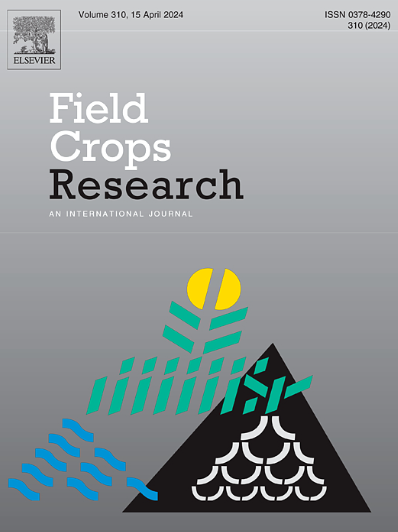Climate suitability determines optimal yielding of dryland maize: A validation on timely sowing as an ancient wisdom
IF 5.6
1区 农林科学
Q1 AGRONOMY
引用次数: 0
Abstract
Context
Climate-based timely sowing is an ancient wisdom, which can facilitate crops to sufficiently utilize climate resources and harvest optimal yielding. However, few studies have validated or addressed this issue from the perspective of climate suitability degree in association with crop maturity and sowing dates.
Objective
1) To explore the sole and integrated effects of sowing dates and crop maturing on maize growth and yielding in dry and wet growing seasons; 2) To reveal the mechanisms of appropriate sowing date affecting yield formation in association of climatic resource utilization; and 3) to validate the ancient wisdom of timely sowing in agricultural production.
Methods
A two-year field experiment was conducted to evaluate the effects of three sowing dates (advanced, SD1; timely, SD2; delayed, SD3) and three maize varieties with early-, medium- and late- maturing (EM, MM and LM) in northwest China. Dry matter accumulation, grain yield, climatic suitability degree, and other related parameters were determined and analyzed.
Results and conclusion
Maize yield performance varied from the growing seasons (dry 2017 and wet 2018) under different sowing dates, but followed a similar trend between two years (i.e. two growing seasons, the same below). In 2017, maize yield was 11.3 % and 22.4 % greater in SD2 than that of SD1 and SD3, respectively (p < 0.05). Similarly, in 2018, it increased by 11.1 % and 18.3 % in SD2 respectively, relative to SD1 and SD3 (p < 0.05). As for the medium- and late-maturing varieties, it appeared to be 7.3 % and 9.8 % greater in 2017, and 25.2 % and 28.6 % greater in 2018 respectively, than the early-maturing one (p < 0.05). Overall, the optimal yielding performance was observed in the late-maturing variety under SD2, up to 7.2 ton ha−1 in 2017 and 10.38 ton ha−1 in 2018 respectively, followed by the medium-maturing variety under SD2. Mechanistically, the highest climate suitability degree across whole growth period (S(C)wgp) was observed in SD2 across three varieties. Regardless of crop maturity, the S(C)wgp was significantly positively correlated with main agronomic traits. Particularly, crop growth rate, leaf area duration, net assimilation rate and maximum relative dry matter accumulation rate performed significantly better in SD2 than those of SD1 and SD3, suggesting that appropriate sowing time can maximize yield potential.
Implications or significance
The findings underscore the importance of timely sowing in maize production, confirming the reasonability and feasibility of timely sowing as an ancient agricultural wisdom based on climate suitability degree.
气候适宜性决定旱地玉米的最佳产量:及时播种作为一种古老智慧的验证
背景基于气候的适时播种是一种古老的智慧,它可以促进作物充分利用气候资源,获得最佳产量。目的1)探讨播种期与作物成熟度对旱季和雨季玉米生长和产量的单独和综合影响;2)揭示适宜播种期与气候资源利用相关联影响产量形成的机制;3)验证适时播种在农业生产中的古老智慧。方法 在中国西北地区进行了为期两年的田间试验,评价了三个播种期(提前播种,SD1;适时播种,SD2;延迟播种,SD3)和早、中、晚熟三个玉米品种(EM、MM 和 LM)的影响。结果与结论在不同播种期下,不同生长季(干旱的 2017 年和潮湿的 2018 年)的玉米产量表现各不相同,但两年(即两个生长季,下同)之间的趋势相似。2017 年,SD2 的玉米产量分别比 SD1 和 SD3 高 11.3 % 和 22.4 %(p <0.05)。同样,2018 年,相对于 SD1 和 SD3,SD2 的玉米产量分别增加了 11.1 % 和 18.3 %(p <0.05)。至于中熟和晚熟品种,与早熟品种相比,2017 年似乎分别增加了 7.3 % 和 9.8 %,2018 年分别增加了 25.2 % 和 28.6 %(p <0.05)。总体而言,SD2条件下晚熟品种的产量表现最佳,2017年和2018年分别达到7.2吨/公顷和10.38吨/公顷,其次是SD2条件下的中熟品种。从机理上看,SD2 下三个品种在整个生长期的气候适宜度(S(C)wgp)最高。无论作物成熟度如何,S(C)wgp 都与主要农艺性状呈显著正相关。结果强调了适时播种在玉米生产中的重要性,证实了根据气候适宜度进行适时播种这一古老农业智慧的合理性和可行性。
本文章由计算机程序翻译,如有差异,请以英文原文为准。
求助全文
约1分钟内获得全文
求助全文
来源期刊

Field Crops Research
农林科学-农艺学
CiteScore
9.60
自引率
12.10%
发文量
307
审稿时长
46 days
期刊介绍:
Field Crops Research is an international journal publishing scientific articles on:
√ experimental and modelling research at field, farm and landscape levels
on temperate and tropical crops and cropping systems,
with a focus on crop ecology and physiology, agronomy, and plant genetics and breeding.
 求助内容:
求助内容: 应助结果提醒方式:
应助结果提醒方式:


